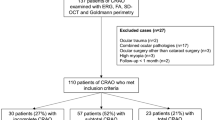Abstract
• Background: In central retinal vein obstruction (CRVO), electroretinogram (ERG) abnormalities and extensive retinal capillary dropout (CD) in the fluorescein angiogram (FA) are good indicators of retinal ischemia. We retrospectively studied patients with unilateral CRVO and compared the ERG and FA results • Methods: Single white flash ERG, photopic ERG, scotopic ERG and flicker ERG were recordered in 30 cases of unilateral CRVO. We analyzed the correlation between the ERG results and the presence/absence of extensive CD • Results: The ERG b/a-wave amplitude ratios, photopic and scotopic b-wave amplitudes, and flicker amplitudes were significantly smaller (P<0.05) in eyes with extensive CD (n=12, 40%), than in eyes without (n=18, 60%). When the photopic or scotopic b-wave amplitudes were normal or supernormal, extensive CD on FA was absent in all eyes. When the b/a-wave ratios were ≥ 1.0 or when the b-wave amplitudes with white flash or flicker amplitudes were normal or supernormal, extensive CD was present in less than 32% of eyes • Conclusion: These results suggest that the ERG results, especially the b/awave amplitude ratio, are significantly correlated with the presence/absence of CD on FA in CRVO.
Similar content being viewed by others
References
Bresnick GH, Wis M (1988) Following up patients with central retinal vein occlusion. Arch Ophthalmol 106:324–326
Breton ME, Quinn GE, Keene SS, Dahmen JC, Brucker AJ (1989) Electroretinogram parameters at presentation as predictors of rubeosis in central retinal vein occlusion patients. Ophthalmology 96:1343–1352
Hayreh SS (1976) So-called ‘central retinal vein occlusion’. I. Pathogenesis, terminology, clinical features. Ophthalmologica 172:1–13
Hayreh SS (1983) Classification of central retinal vein occlusion. Ophthalmology 90:458–474
Hayreh SS, Rojas P, Podhajsky P, Montague P, Woolson RE (1983) Ocular neovascularization with retinal vascular occlusion. III. Incidence of ocular neovascularization with retinal vein occlusion. Ophthalmology 90:488–506
Hayreh SS, Klugman MR, Podhajsky P, Kolder HE (1989) Electroretinography in central retinal vein occlusion. Correlation of electroretinographic changes with pupillary abnormalities. Graefe's Arch Clin Exp Ophthalmol 227:549–561
Hayreh SS, Klugman MR, Beri M, Kimura AE, Podhajsky P (1990) Differentiation of ischemic from nonischemic central retinal vein occlusion during the early acute phase. Graefe's Arch Clin Exp Ophthalmol 228:201–217
Johnson MA, Marcus S, Elman MJ, McPhee TJ (1988) Neovascularization in central retinal vein occlusion. Electroretinographic findings. Arch Ophthalmol 106:348–352
Kaye SB, Harding SP (1988) Early electroretinography in unilateral central retinal vein occlusion as a predictor of rubeosis iridis. Arch Ophthalmol 106:353–356
Laatikainen L, Kohner EM (1976) Fluorescein angiography and its prognostic significance in central retinal vein occlusion. Br J Ophthalmol 60:411–427
Laatikainen EM, Kohner M, Khoury D, Blach K (1977) Panretinal photocoagulation in central retinal vein occlusion: a randomised contralled clinical study. Br J Ophthalmol 61:741–753
Magargal LE, Brown G, Augsburger JJ, Parrish RK II (1981) Neovascular glaucoma following central retinal vein obstruction. Ophthalmology 88:1095–1101
Magargal LE, Brown G, Augsburger JJ, Donoso LA (1982) Efficacy of panretinal photocoagulation in preventing neovascular glaucoma following ischemic central retinal vein obstruction. Ophthalmology 89:780–784
Matsui Y, Katsumi O, McMeel JW, Hirose T (1994) Prognostic value of electroretinogram (ERG) in central retinal vein obstruction (CRVO). Graefe's Arch Clin Exp Ophthalmol 75–81
Peterson H (1968) The normal b-potential in the single-flash clinical electroretinogram. Acta Ophthalmol [Suppl] 99:5–77
Sabates R, Hirose T, McMeel JW (1983) Electroretinography in the prognosis and classification of central retinal vein occlusion. Arch Ophthalmol 101:232–235
Sakaue H, Katsumi O, Hirose T (1989) Electroretinographic findings in fellow eyes of patients with central retinal vein occlusion. Arch Ophthalmol 107:1459–1462
Welch JC, Augsburger JJ (1987) Assessment of angiographic retinal capillary nonperfusion in central retinal vein occlusion. Am J Ophthalmol 103:761–766
Author information
Authors and Affiliations
Rights and permissions
About this article
Cite this article
Matsui, Y., Katsumi, O., Mehta, M.C. et al. Correlation of electroretinographic and fluorescein angiographic findings in unilateral central retinal vein obstruction. Graefe's Arch Clin Exp Ophthalmol 232, 449–457 (1994). https://doi.org/10.1007/BF00195353
Received:
Revised:
Accepted:
Issue Date:
DOI: https://doi.org/10.1007/BF00195353




